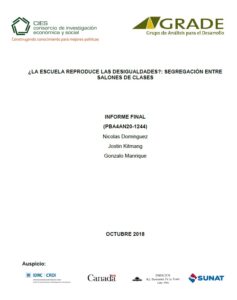¿La escuela reproduce las desigualdades?: segregación entre salones de clases
| Year | : | 2018 |
|---|---|---|
| Author/s | : | Nicolás Domínguez, Jostin Kitmang, Gonzalo Manrique |
| Area/s | : | Education and learning |
Dominguez, N., Kitmang, J. y Manrique, G. (2018). ¿La escuela reproduce las desigualdades?: segregación entre salones de clases (Informe final). Lima. CIES.
Most of the studies have focused on explaining the differences in educational achievements through the differences in the characteristics of schools. However, little have been done in assessing the gaps existing within the same schools. This paper’s objective is to assess how student segregation—the method of separating students in classrooms according to their grades—affects their perfomance in the school. First, the study identify student segregation using non-parametric tests. Second, the paper assesses the factors associated with the decision of a school to segregate their students. Third, the study estimates the possible effects of student segregation on educational achievemnt. A national student evaluation is used in order to capture the impact on math and reading comprehension performance. The results suggest that student segregation affects negatively educational achievement, especially the ones assigned to the lower-perfoming classrooms. Additionally, segregation affects more girls and native-language speaking students. In conclusion, student segregation amplifies the existing gaps.






